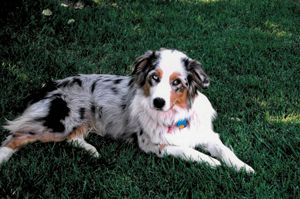Mind Over Miller: A really good dog
See that dog with me in the upper left-hand corner of the page? That was Rosie.
See that dog with me below? That was Rosie. I wrote about her in my January 2003 column. We discovered she had cancer when she was 9, but thanks to two colleagues who are also my friends, Dr. Jim Felts and Dr. Alice Villalobos, Rosie lived three more years, with a good quality of life until her last days.
Except for the first dog my wife and I got as newlyweds, all of our dogs have been Australian shepherds of the same bloodline. That first dog, Wendy, was a former patient in Arizona. She was an Australian shepherd-English shepherd cross. Both breeds are misnomers because both are American stock dogs. The Australian shepherd descended from herding dogs in the Basque region, between France and Spain. They came to California from Australia with Basque herders and shiploads of sheep after the discovery of gold in the mid-19th century.

Robert M. Miller, DVM
In practice, I was always amused by clients who owned Australian shepherds and gave them names like Dingo or Outback. They were so disappointed to learn the breed originated in the United States.
I remember a visiting Australian colleague being shocked when she asked what kind of dogs I had in my car and I answered, "Australian shepherds." She indignantly replied, "They're what? There's no such thing!"
The Australians have great stock dogs of their own, such as the kelpie and the Queensland—or blue—heeler. Of course, now we have kelpies and heelers in the U.S., and Australia finally has Australian shepherds.
Actually, there are only two kinds of stock dogs in the world: border collies and all the rest. The border collie is unquestionably the most intelligent breed and the best of all stock dogs. But border collies' work ethic is so intense that many of them are not ideal family dogs. That's why I have Australian shepherds.

After Wendy, I got my first purebred Australian shepherd from a colleague, retired veterinarian Weldon Heard of Roseburg, Ore. Molly was the best dog I ever owned. Mentally and physically, she was free of faults. Perfect in every way, she lived to 15, leaving us with two of her pups. Of course, they too passed on long ago. We have a lot of dogs buried in our pasture.
Dr. Heard's dogs, the Flintridge bloodline, are the only dogs we have owned since we got Molly. The more Flintridge in them, the better they were. Those with less Flintridge breeding were still good dogs, but the great dogs we have owned were those with the most Flintridge breeding. Thank you, Dr. Heard!
After Rosie died, we drove a thousand miles to replace her with Daisy (pictured above). You can see by this photograph how similar she looks to her predecessor. Of course, no two dogs are ever alike, and she is quite different from Rosie. Our other dog, Sugar Bear (we did not name her), visibly mourned Rosie's death. That ended when we brought the new pup home. Daisy filled the gap in all our hearts.
As a practitioner, I observed many times that although I like most dogs, there isn't one in a thousand that I want in my home. I have been blessed by having good dogs all of my life.
Editors' note: Read Dr. Miller's January 2003 column about Rosie at www.vetmedpub.com/Rosie.
Robert M. Miller, DVM, is an author and a cartoonist, speaker, and Veterinary Medicine Practitioner Advisory Board member from Thousand Oaks, Calif. His thoughts in "Mind Over Miller" are drawn from 32 years as a mixed-animal practitioner. Visit his Web site at www.robertmmiller.com.